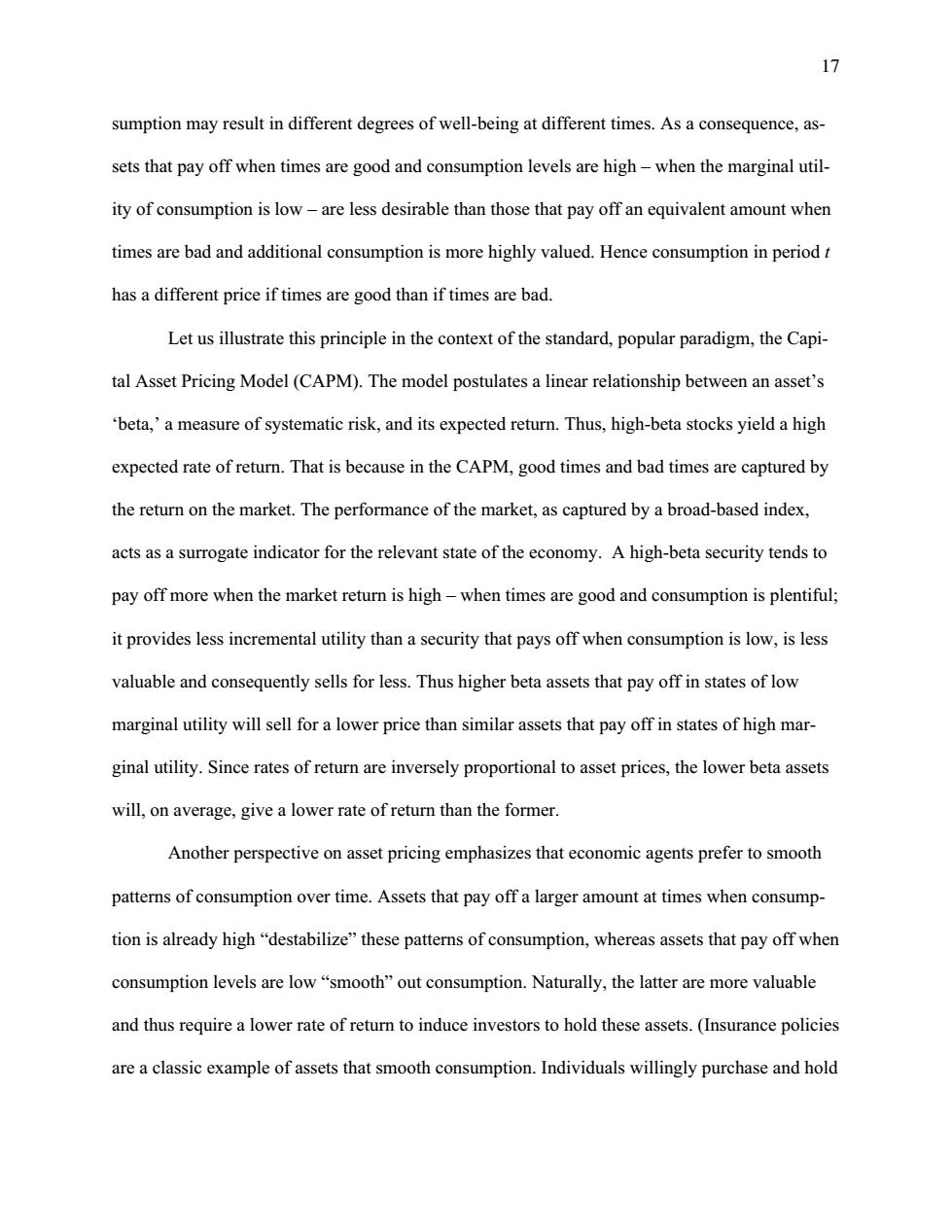正在加载图片...

17 sumption may result in different degrees of well-being at different times.As a consequence,as- sets that pay off when times are good and consumption levels are high-when the marginal util- ity of consumption is low-are less desirable than those that pay off an equivalent amount when times are bad and additional consumption is more highly valued.Hence consumption in period t has a different price if times are good than if times are bad. Let us illustrate this principle in the context of the standard,popular paradigm,the Capi- tal Asset Pricing Model(CAPM).The model postulates a linear relationship between an asset's 'beta,'a measure of systematic risk,and its expected return.Thus,high-beta stocks yield a high expected rate of return.That is because in the CAPM,good times and bad times are captured by the return on the market.The performance of the market,as captured by a broad-based index, acts as a surrogate indicator for the relevant state of the economy.A high-beta security tends to pay off more when the market return is high-when times are good and consumption is plentiful; it provides less incremental utility than a security that pays off when consumption is low,is less valuable and consequently sells for less.Thus higher beta assets that pay off in states of low marginal utility will sell for a lower price than similar assets that pay off in states of high mar- ginal utility.Since rates of return are inversely proportional to asset prices,the lower beta assets will,on average,give a lower rate of return than the former. Another perspective on asset pricing emphasizes that economic agents prefer to smooth patterns of consumption over time.Assets that pay off a larger amount at times when consump- tion is already high "destabilize"these patterns of consumption,whereas assets that pay off when consumption levels are low "smooth"out consumption.Naturally,the latter are more valuable and thus require a lower rate of return to induce investors to hold these assets.(Insurance policies are a classic example of assets that smooth consumption.Individuals willingly purchase and hold17 sumption may result in different degrees of well-being at different times. As a consequence, assets that pay off when times are good and consumption levels are high – when the marginal utility of consumption is low – are less desirable than those that pay off an equivalent amount when times are bad and additional consumption is more highly valued. Hence consumption in period t has a different price if times are good than if times are bad. Let us illustrate this principle in the context of the standard, popular paradigm, the Capital Asset Pricing Model (CAPM). The model postulates a linear relationship between an asset’s ‘beta,’ a measure of systematic risk, and its expected return. Thus, high-beta stocks yield a high expected rate of return. That is because in the CAPM, good times and bad times are captured by the return on the market. The performance of the market, as captured by a broad-based index, acts as a surrogate indicator for the relevant state of the economy. A high-beta security tends to pay off more when the market return is high – when times are good and consumption is plentiful; it provides less incremental utility than a security that pays off when consumption is low, is less valuable and consequently sells for less. Thus higher beta assets that pay off in states of low marginal utility will sell for a lower price than similar assets that pay off in states of high marginal utility. Since rates of return are inversely proportional to asset prices, the lower beta assets will, on average, give a lower rate of return than the former. Another perspective on asset pricing emphasizes that economic agents prefer to smooth patterns of consumption over time. Assets that pay off a larger amount at times when consumption is already high “destabilize” these patterns of consumption, whereas assets that pay off when consumption levels are low “smooth” out consumption. Naturally, the latter are more valuable and thus require a lower rate of return to induce investors to hold these assets. (Insurance policies are a classic example of assets that smooth consumption. Individuals willingly purchase and hold